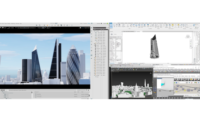Preparing multiple potential designs around narrow requirements is seen as some of the most tedious work in design and engineering. But some of that effort can now be automated with the new generative design scripting built into Autodesk Revit 2021.
Generative design is a form of parametric design, where an algorithm is fed preset criteria for a final design and attempts to generate shapes and layouts that meet those requirements. Generative design has been used in limited capacity in architecture and engineering in the past, but Autodesk now offers the ability to run generative design iterations within Revit, using its Dynamo scripting tool. Three sample “studies” are included in Revit 2021, but users are free to write their own generative design parameters in Dynamo.
Available as a beta test for the last two years, the generative design option is now fully integrated into the Revit 2021 release. While scripting these studies takes some knowledge of Dynamo, once they’re built it’s a simple process for any existing Revit user to run them, says Lilli Smith, Autodesk senior project manager for AEC generative design. “It uses Revit objects, Revit contexts,” she explains. “You can choose the result you like and quickly load up that whole model into Revit.” Once generated, the designs can be loaded directly into Revit, either as a mass or with floors other detailing included. Running Generative Design can take several seconds to up to a few minutes, but Smith says any computer powerful enough to run Revit should be able to handle it.
Basic uses for Revit's Generative Design include evaluating possible designs for daylighting, interior layouts and maximizing usable floor space in a tight building site. But Smith says there are also uses for generative design in heavy civil, and users have already applied it there to test ideas. "It really enables you to have discussion with stakeholders on what's important," she says.
“We see this as a complementary feature. We are not replacing an architect,” says Vikram Dutt, Autodesk vice president for building design strategy. “You can do more iterations and explore different options, and remove some of the more time-consuming tasks.”




Post a comment to this article
Report Abusive Comment